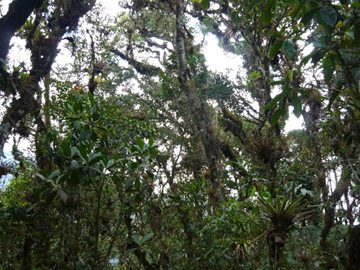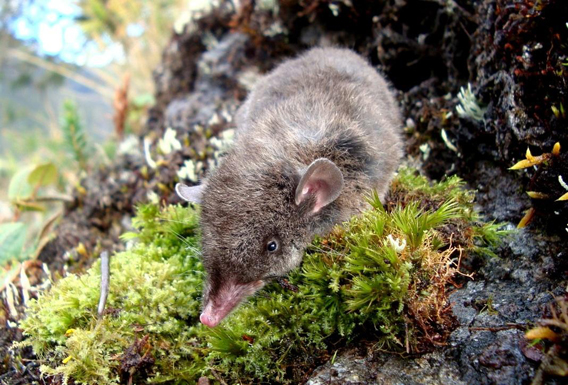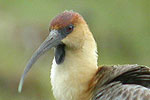
Possible new species of night monkey in the Aotus genus. Photo by: Alexander Pari.
Every year scientists describe around 18,000 new species, but mammals make up less than half a percent of those. Yet mammal surprises remain: deep in the remote Peruvian Andes, scientists have made an incredible discovery: a rich cloud forest and alpine grassland ecosystem that may be home to no less than eight new mammal species. Although most of these new mammals are currently under study—and have not been officially described yet (a process which can take several years)—lead scientists, Horacio Zeballos of Peru and Gerardo Ceballos of Mexico are certain they have uncovered a small forest, surrounded by deforestation and farmland, that shelters a remarkable menagerie of mammals unknown to scientists until now.
Discovered in the Tabaconas-Namballe National Sanctuary, which covers 32,000 hectares (70,000 acres), the mammals include probable new species of a night monkey, a porcupine, an olingo (a tree-dwelling animals related to raccoons), a marsupial, a shrew, and four rodents. The scientists also discovered what they believe could be a new species of gray fox.
For Zeballos, with the Arequipa Museum of Natural History, the new marsupial is especially intriguing.
 Cloud forest in the Tabaconas-Namballe National Sanctuary Photo by: Gerardo Ceballos. |
“I was extremely perplexed when I discovered among the small mammals a new species of a South American marsupial of Paucituberculata Order, far larger in size than all three Peruvian known species,” he said in a press release. In fact the marsupial is nearly double the size of its relatives, which are only three in the Caenolestes genus.
Zeballos, along with Gerardo Ceballos with the Universidad Nacional Autonoma de Mexico, surveyed the park in 2009 and 2011. The experts plan to return again this November.
In addition to the new mammals, scientists have uncovered three new species of amphibians in park, one of which—Pristimantis bustamante—has been already described.
“If there are this many new large species, imagine what we might find from the insect world,” said Ceballos.
More new mammals may still be found too. Locals report another mystery porcupine with orange-colored skin.
Although less-studied and receiving less conservation attention than lowland tropical forest, cloud forests may be the world’s most species-rich ecosystems, often containing a wide variety of species found no-where-else. But even for a cloud forest, the Tabaconas-Namballe National Sanctuary, about the size of Malta, is a small area to contain so many unknown species. Reaching the sanctuary’s station requires flying to Chiclayo, a city in northern Peru, followed by an 18-hour drive and a two hour hike. It was during the drive that researchers spotted the gray fox, which may be a new species and is certainly the furthest south this animal has ever been recorded. The gray fox’s current range ends in northern Colombia and Venezuela, thousands of miles away.
Even without the amazing discoveries, Tabaconas-Namballe National Sanctuary is a treasure trove of biodiversity, despite being little-known. To date, 85 mammals, 326 birds, and 23 reptiles and amphibians have been recorded in the reserve, which is also home to big charismatic species like the mountain tapir (Tapirus pinchaque), listed as Endangered by the IUCN Red List, and the spectacled bear (Tremarctos ornatus), listed as Vulnerable.
Ongoing deforestation surrounding the park, however, threatens its resilience. In addition, illegal hunting and mining remain entrenched problems for Tabaconas-Namballe National Sanctuary. Finally, climate change is adding pressure to cloud forests worldwide. Still the new discoveries may be pushing for more action to aid the reserve: Wildlife Extra reports that authorities are currently considering a plan to create a wildlife corridor that would connect Tabaconas-Namballe National Sanctuary to a nearby protected area.

Common shrew opossum (Caenolestes caniventer). This species is one of the three related to the new marsupial discovered in Tabaconas-Namballe National Sanctuary. Only the new species is a ‘giant’ compared to this one. Photo by: Kateryn Pino.

The enigmatic bicolored-spined porcupine in the genus Couendu. This possibly new species has incredibly long spines. Photo: Alexander Pari.

The possible new gray fox is similar to this specimen from Mexico (Urocyon cinereoargenteus). Either way Tabaconas-Namballe National Sanctuary is the furthest south a gray fox has been observed. Photo by: Gerardo Ceballos.

A likely new species small-eared shrew in the Cryptotis genus. Photo by: César Medina.

A new frog in the Pristimantis genus from Tabaconas-Namballe National Sanctuary. Photo by: Roberto Gutiérrez.
Paramo grassland. Photo by: César Medina.
Related articles
Pictures: Bolivian park may have the world’s highest biodiversity

(09/12/2012) With over 90 species of bat, 50 species of snake, 300 fish, 12,000 plants, and 11 percent of the world’s bird species, Madidi National Park in Bolivia may be the world’s most biodiverse place, according to new surveys by the the Bolivian Park Service (SERNAP) with aid from the Wildlife Conservation Society (WCS).
Private reserve safeguards newly discovered frogs in Ecuadorian cloud forest

(08/28/2012) Although it covers only 430 hectares (1,063 acres) of the little-known Chocó forest in Ecuador, the private reserve las Gralarias in Ecuador is home to an incredible explosion of life. Long known as a birder’s paradise, the Reserva las Gralarias is now making a name for itself as a hotspot for new and endangered amphibians, as well as hundreds of stunning species of butterfly and moth. This is because the reserve is set in the perfect place for evolution to run wild: cloud forest spanning vast elevational shifts. “The pacific slope cloud forests […] are among the most endangered habitats in the world,” explains Reserva las Gralarias’ founder, Jane Lyons, in a recent interview with mongabay.com.
Beautiful new bird discovered in Peruvian cloud forest
(08/07/2012) Four years ago in a remote cloud forest in Peru’s Cerros del Sira mountain range, three recently graduated students from Cornell University discovered a never-before-recorded species of black, white, and scarlet bird. Now described in the scientific journal, The Auk, the bird has been dubbed the Sira barbet (Capito fitzpatricki).
New colorful rainforest frog named after Prince Charles (PICTURES)
(07/04/2012) Researchers have discovered a previously unknown species of frog and named it in honor of Price Charles, according to a paper published in the journal Zootaxa.
Cloud forests may be particularly vulnerable to climate change
(03/26/2012) Mexico could lose nearly 70 percent of its cloud forests due to climate change by 2080, according to new research published in Nature Climate Change, that has implications for cloud forests worldwide.
3 new private conservation reserves established by communities in Peru
(03/21/2012) Three new private conservation areas in the Amazon-Andes region of Peru will help buffer the country’s national park system while offering new opportunities for local people to benefit from protecting ecosystems.
Majority of Andes’ biodiversity hotspots remain unprotected

(02/01/2012) Around 80 percent of the Andes’ most biodiverse and important ecosystems are unprotected according to a new paper published in the open-access journal BMC Ecology. Looking at a broad range of ecosystems across the Andes in Peru and Bolivia, the study found that 226 endemic species, those found no-where else, were afforded no protection whatsoever. Yet time is running out, as Andean ecosystems are undergoing incredible strain: a combination of climate change and habitat destruction may be pushing many species into ever-shrinking pockets of habitat until they literally have no-where to go.
Volcano and cloud forests conserved in Ecuador

(12/05/2011) Conservation organizations and the Ecuadorian government have succeeded in securing over 250,000 acres (106,000 hectares) of cloud forest and grasslands surrounding the Antisana Volcano for protection. The area, long-used for cattle ranching, is home to Andean condors (Vultur gryphus), cougars (Puma concolor), Andean fox (Lycalopex culpaeus), silvery grebes (Podiceps occipitalis), black-faced ibis (Theristicus melanopis), spectacled bear (Tremarctos ornatus), and three species of endangered frogs. The protected area stretches from 3,900 feet (1,188 meters) to 18,700 feet (5,699 meters) above sea level.
